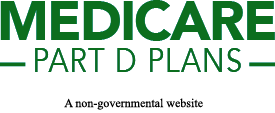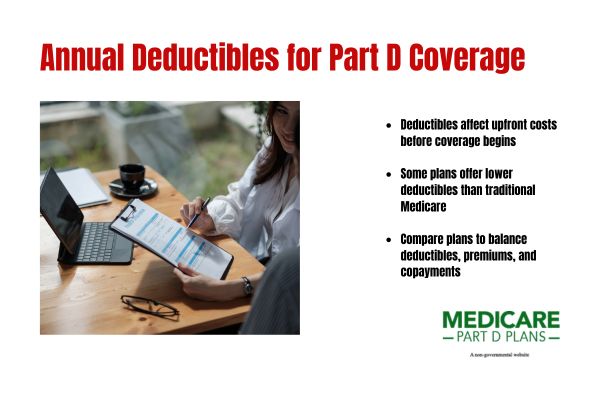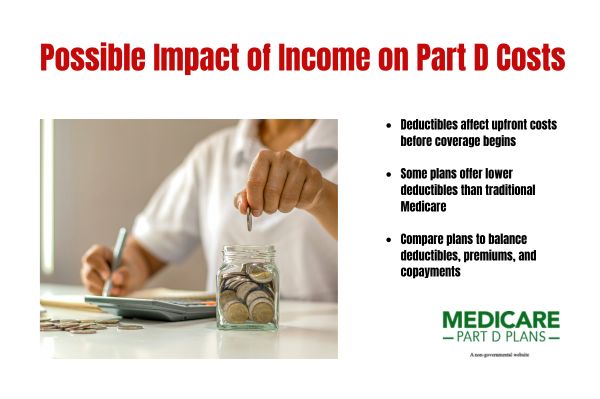Find a Medicare Part D prescription drug plan

Medicare Part D
Prescription Drug Coverage 2026
Cost of Part D Medicare in 2026
Looking for the potential cost of Part D Medicare
Key Takeaways
- The average monthly premium for some Medicare Part D plans may be lower than traditional Medicare.
- Certain plans may also provide lower annual deductibles for certain services, which could potentially minimize certain upfront costs for beneficiaries.
- Possible changes
in 2026 might include allowing individuals receiving Medicaid or Extra Help to change their Medicare drug plans monthly.
Overview of Medicare Part D Costs in 2026
Medicare Part D could potentially offer prescription drug coverage to help cover some of the costs of medications. This potential coverage might reduce the financial burden of prescription drugs, likely making essential medications more accessible.
Understanding the breakdown of these potential costs will likely be the first step in managing your healthcare expenses effectively.
The three primary costs that might be associated with Medicare Part D plans may include:
- Premiums: The monthly premium is the amount you pay each month for coverage under your Medicare Part D plan.
- Annual deductibles: The amount you must pay out-of-pocket each year before your insurance begins to cover the costs of your medications.
- Copayments and coinsurance: The amounts you pay when you fill a prescription, with the specific amounts varying based on your plan’s tier system.
The amount you pay for Medicare Part D may vary based on the prescription drug plan you choose. Different plans could offer different levels of coverage and cost-sharing arrangements, likely allowing beneficiaries to select a plan that best fits their medication needs and budget.
This potential flexibility could be key to finding the most cost-effective solution for your prescription drug coverage.
Monthly Premiums for Part D Plans
One of the first costs you’ll likely encounter with Medicare Part D is the monthly premium. The premium will likely act as a manageable monthly expense, but it’s essential to consider it as part of your overall healthcare budget.
The monthly premium might vary depending on the type of plan selected, highlighting the importance of comparing different plans and understanding what you’re paying. Certain plans may also offer lower premiums compared to traditional Medicare, which could be an excellent option for those who meet the eligibility criteria, possibly providing substantial savings on monthly costs.
Understanding the available options and eligibility requirements for these plans could potentially reduce your out-of-pocket costs, likely ensuring you get the coverage you need without breaking the bank.
Annual Deductibles for Part D Coverage
Annual deductibles will likely be another critical component of your potential Medicare Part D costs. This means that before your plan starts to pay its share, you will likely need to pay a certain out of pocket cost for various services. The deductible could significantly impact your upfront costs, so it’s crucial to budget for this expense.
Not all plans have the same deductible. Some Medicare Part D plans may offer lower deductibles compared to traditional Medicare, possibly allowing for lower upfront cost options for enrollees.
These potential benefits could be particularly beneficial for those who require regular medications and want to minimize their initial out-of-pocket expenses.
Choosing a plan that might offer a lower deductible could potentially reduce the financial burden at the beginning of the year, but it’s essential to weigh this against other possible costs, such as premiums and copayments. By carefully comparing plans, you could find a balance that suits your financial situation and healthcare needs.
Copayments and Coinsurance
Once you’ve met your deductible, you may also encounter copayments and coinsurance. A copayment is the fixed amount you pay out of pocket to fill a prescription. Various Medicare Part D plans will likely utilize copay tiers, which are levels with different copay or coinsurance amounts for drugs.
These tiers could help categorize medications based on their cost, with generic drugs typically falling into lower tiers and brand-name or specialty drugs in higher tiers.
During the initial coverage phase:
- This phase begins after you’ve met your deductible stage.
- It will likely continue until your total drug costs reach a certain limit.
- Coinsurance for higher-tier drugs will likely be calculated as a percentage of the drug price.
- More expensive medications might result in higher out-of-pocket costs during this phase and may also affect other cost sharing amounts.
In the catastrophic coverage stage, the plan may cover up to 60% of costs. This phase begins once you’ve reached the out-of-pocket maximum, which could provide significant financial relief for those with high out-of-pocket expenses.
Understanding these different cost-sharing phases could help you better manage your covered certain expenses throughout the year.
How to Lower Your Prescription Drug Costs
Lowering your prescription drug costs could potentially make a significant difference in managing your overall healthcare expenses. One possible strategy might be to use generic medications instead of brand-name drugs, which could lead to substantial savings.
Generic medications:
- Are required to have the same active ingredients as their brand-name counterparts
- May have the same efficacy as brand-name drugs
- Could potentially serve as a cost-effective alternative
By exploring these various options and staying informed about potential changes in Medicare Part D, you could effectively manage your prescription drug costs.
Possible Impact of Income on Part D Costs
Income levels could play a critical role in determining your Medicare Part D costs. Applying for the Extra Help program could potentially reduce costs for Medicare drug coverage.
This program has been designed to assist those with limited incomes, possibly ensuring they could afford their necessary medications. Individuals who qualify for Extra Help may find that their payments could be more manageable.
The Inflation Reduction Act (IRA) of 2022 may also aid members by helping to reduce some of their expenses on certain prescription drugs. This legislation might introduce measures to help cap out-of-pocket expenses and possibly make medications more affordable for Medicare beneficiaries.
Understanding the potential impact of income on your eligibility could help you better manage your healthcare expenses and take advantage of available assistance programs.
Reviewing your income and applying for any qualifying programs could potentially reduce your overall Medicare Part D costs. By doing so, you could potentially ensure that you’re not paying more than necessary for your prescription drug coverage.
See plans in your area instantly!
Advertisement
Comparing Part D Plans
Comparing Part D plans will likely be essential to finding the best coverage for your needs. The plan finder tool on this website is a valuable resource that helps users compare different plans that are available to them.
By entering your zip code and specific medications, you can receive tailored data about the available plans and their costs.
By using our website, you can:
- Compare total expenses, such as premiums, deductibles, and copayments, to help make an informed decision.
- Filter Part D plans based on your specific medication needs and budget, ensuring you find a plan that fits your healthcare requirements.
Plan availability and costs may vary significantly by geographic location, which is why it’s essential to enter your zip code when using the comparison tool. By taking the time to compare plans, you will likely find the most cost-effective option for your prescription drug coverage.
Possible Penalties for Late Enrollment
Enrolling in Medicare Part D on time is crucial to avoid penalties. The late enrollment penalty for Medicare Part D may be permanently added to your premium if there is a gap of 63 days or more in coverage after your initial enrollment period. This penalty is calculated at 1% of the national base beneficiary premium for each month without creditable drug coverage.
This penalty is applied indefinitely, as long as you maintain Medicare drug coverage. Understanding the financial consequences of late enrollment could help you make timely decisions about your Medicare Part D coverage.
To avoid these penalties, it’s essential to enroll in Medicare Part D during your initial enrollment period or maintain creditable drug coverage through another source. Being proactive about your enrollment could save you from unnecessary costs in the long run.
Find a Plan and Enroll Online Yourself!
Advertisement
Summary
Understanding the potential costs associated with Medicare Part D will likely be crucial for managing your healthcare expenses effectively. From monthly premiums and annual deductibles to copayments and out-of-pocket maximums, each component will likely play a significant role in your overall costs. By staying informed and utilizing available resources, you can navigate your Medicare Part D plan with confidence.
By taking advantage of assistance programs, comparing plans, and staying proactive about your enrollment, you could potentially ensure that you’re getting the most out of your Medicare Part D coverage. Remember, staying informed will likely be the key to managing your healthcare costs effectively and ensuring you have the coverage you need.
Frequently Asked Questions
How much is the average monthly premium for Medicare Part D in 2026 ?
Unfortunately, the plan details
What is the standard deductible for Medicare Part D in 2026 ?
The standard deductible is a set amount that may apply to beneficiaries unless their plan offers a lower deductible.
What is the out-of-pocket spending limit for Medicare Part D in 2026 ?
The out-of-pocket spending limit could potentially reduce and help manage costs for beneficiaries.
How is the late enrollment penalty for Medicare Part D calculated?
The late enrollment penalty for Medicare Part D is calculated by taking 1% of the national base beneficiary premium for each month you go without creditable drug coverage. This penalty will likely be added to your monthly premium and lasts for as long as you are enrolled in Part D.
Begin Choosing your plan
Advertisement
ZRN Health & Financial Services, LLC, a Texas limited liability company.



